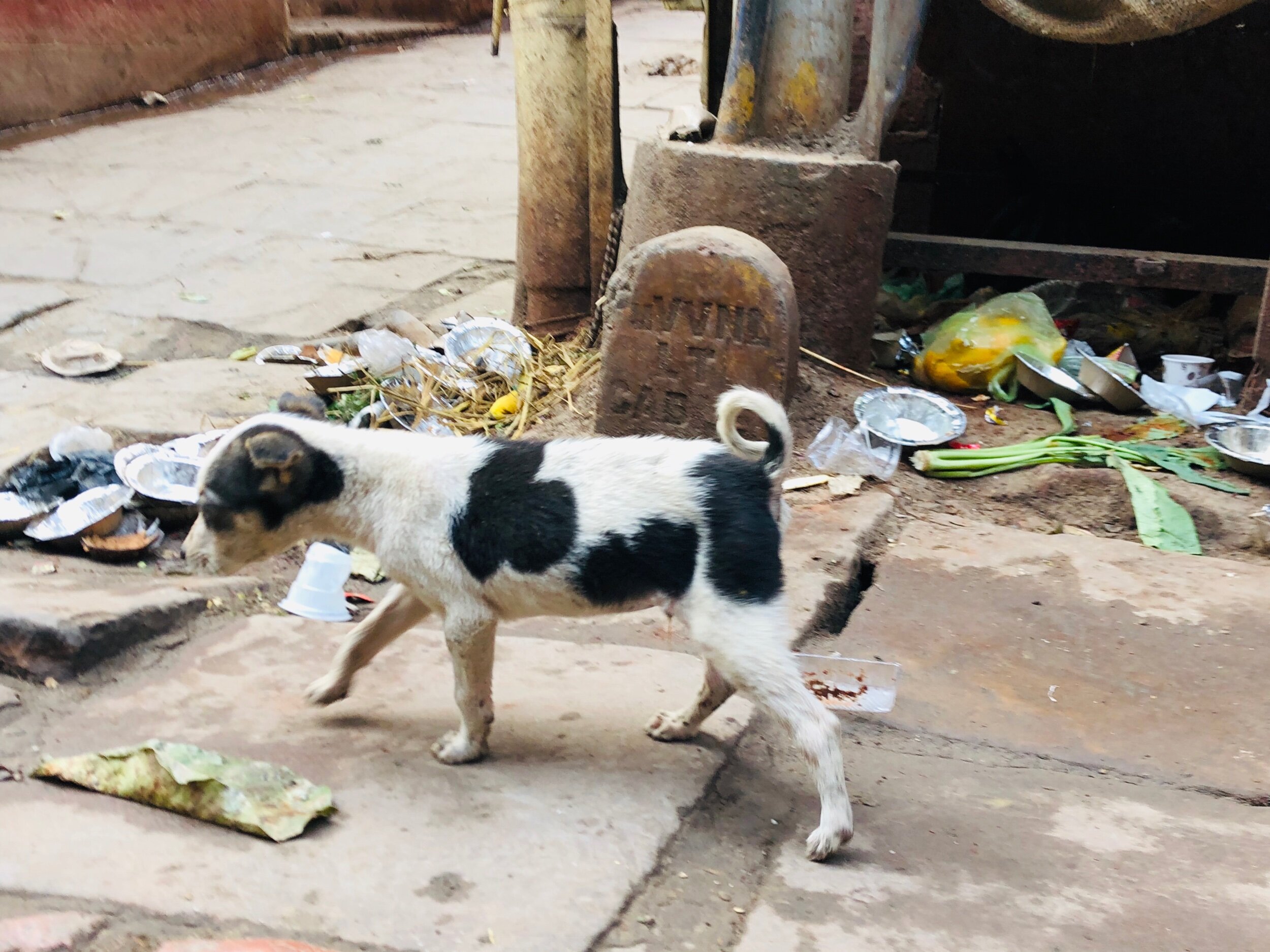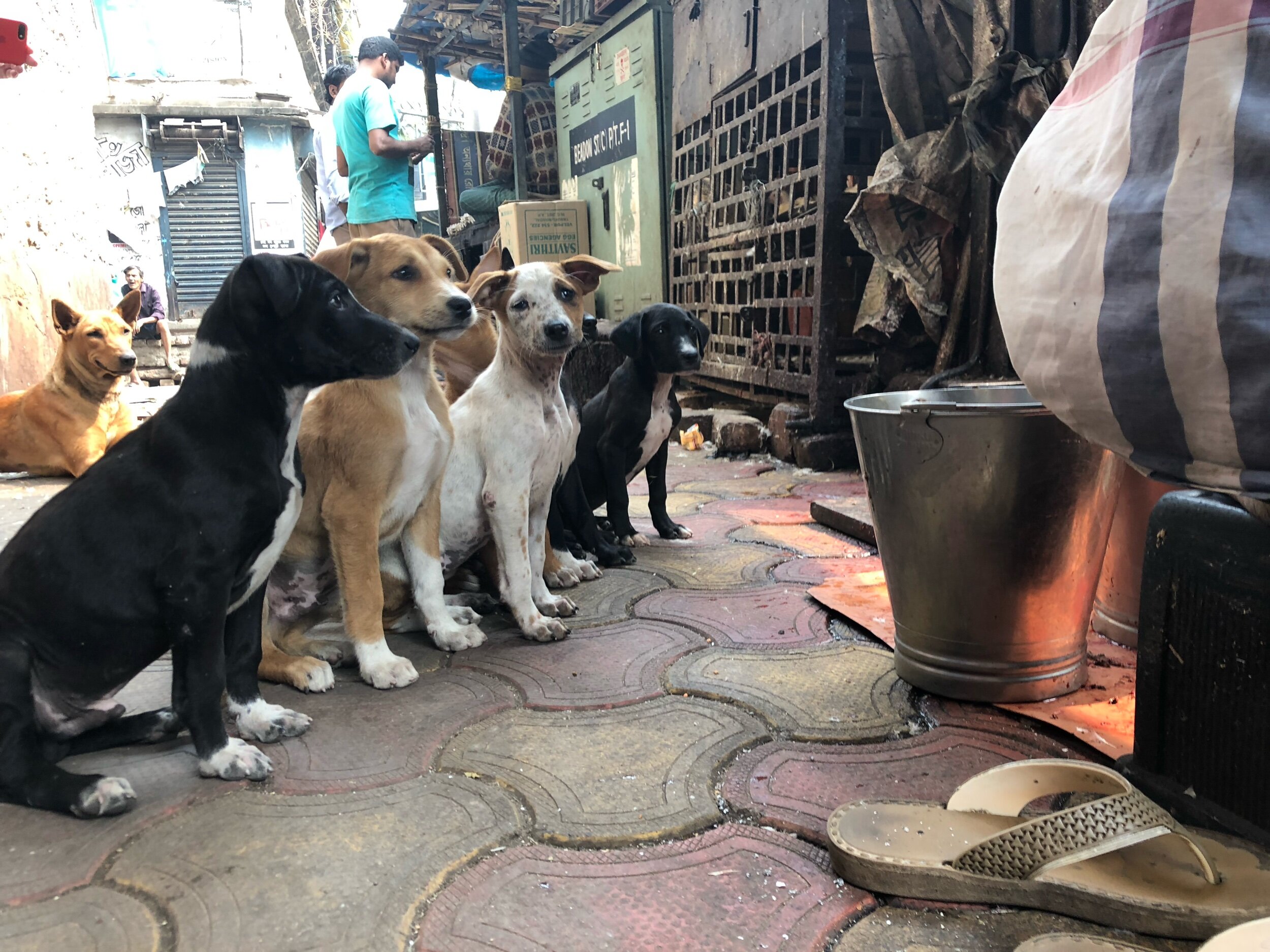I run photography tours to India, and on the Sacred Rivers trip 2019 I travelled with clients to India to Delhi, Allahabad, Varanasi and Kolkata. All places where India's hounds are unloved and kicked about. Over the year's it's been something I've tried not to focus on as it upsets and disturbs me, that people can be so unkind to one of humankind's best allies.
Pie dogs. Paee kutta in Hindi. Pal kukura in Bengali. Not that most street dogs would know any name other than a swift kick, or any affection other than a raised hand. Dogs are objects of contempt, their yelps heard daily in the melee of street life. I have rescued puppies in Himachal, persuaded my good friend Mini to take a pie dog into her home and love it, been chased by a pack of street dogs one late night on honeymoon in Jaisalmer, and generally kept myself well clear of India's street dogs with their rabies and fleas. And sharp teeth. Until this trip.
India always humbles, always surprises. This time, the people of India managed to catch me out me with an unexpected element of humanity. For wherever I went, dogs were being petted, fed and loved. After 25 years of knocking around the subcontinent this was the first time I have ever seen anything like affection for street dogs. Maybe I wasn't paying attention. Maybe there's been a little shift in people's behaviour. Maybe it happens in places where there's a strong spiritual undercurrent, or there's a specific need for the dog to take care of its feeders. This is the story of recently met (and photographed) hounds in India.
I spent a very interesting morning on the banks of the Yamuna River in Delhi, east of Civil Lines, where the Tibetan Monastery lies on the shores of one of Mother Ganga's great tributaries. I was keen to see the place for myself, and not the Instagram images of perfect boats with flocks of seagulls. The Yumana flows wide and shallow at this point, and if you look at satellite maps you can see the large sand bank in the middle, and the agricultural crops on the east bank, grown to take advantage of monsoon floods. On the banks the morning I'm poking about, there are a range of lost souls camping and washing, taking advantage of an empty place in a busy city. I've been warned that drug addicts and dodgy types inhabit this neck of the woods, so I'm careful to not wave my camera about or go too far from the safety of the Tibetan Bazaar. As I stand and observe, I notice a sweet scene unfolding. There's a guy sitting down (Indian style) about 400 yards from me, belongings wrapped in a dhoti, stick not far to hand. He is stroking a piedog affectionately, chatting to it in Hindi. The dog is enjoying the attention, and they commune for a while. After a little bit the man gets his stuff together and starts to get up, and the dog ambles away.
My reaction to this is complicated. Never before have I seen dogs being petted in this way by anyone not middle-class Indian, to be frank. I am happy to have observed, unobserved, the scene, and it gives me food for thought. I return to the chai stand at the back of the bazaar, to be surprised yet again by kind behaviour to dogs.
As I arrive there is a young Tibetan lady walking with a big cooking pot, and a trail of puppies following her. She calls to the mother, who trots up in a pretty keen manner, and the lady commences feeding rice and whatnot to the gang of pups and mum. Again, not something I have seen before. Buddhists are known for their love of dogs, but in a quarter of a century of travels to the subcontinent, I had not experienced street dogs being fed. I take a few pics of the action, and then find a number of dogs sitting on the wall of the Tibetan bazaar, looking across to the sands of the Yamuna and generally behaving in non-aggressive ways. These dogs are clearly being looked after yet are street dogs in that nobody owns them. I spy another, nestling in a neat bed made for it in a corner of the wall, and again, notice these dogs are home and happy. They come over to chat to me and say hello, always aware when they are being looked sat and examined. I am continually surprised how much dogs know about what's going on. They probably smelled me as I came in the gates of the Tibetan Bazaar, and knew about my presence long before I knew about theirs.
Feeding time, tibetan BAzAar, Civil lines, delhi
Dog beD
Post breakfast stroll
Varanasi is a city of a million souls all looking for moksha. The ghats are a complicated riot of pilgrims, sadhus, touts, sellers of marigolds and candles for votive offerings. There are guys chucking magnets in on strings, fishing for pice, (pi -sa, Hindi for coins), rowing boats keen to float you down the Ganges, old temples, old steps, sweepers, young priests, fortune tellers. Cremation ghats. And dogs. Nothing quite prepares you for it and it is one of the most amazing places on the planet. I love it. If you want to go to India on a photography trip, take me with you to Benares, Kashi, Varanasi, the city of three names, where you fast track to salvation.
“Varanasi is a city of a million souls all looking for moksha. ”
Varanasi's dogs seem to have one father as they all have similar ears and head shape. They are a fine beast to look at. The hounds in the ghats were an aesthetic pleasure, curled up in the sun, enjoying the warmth of a hearth set up by sadhus. Lying on the ghats, rushing about the ghats in complicated games, they added an unexpected dimension. I noticed that the chai wallahs had placed hessian sacks on the steps, some of which were clearly meant for the dogs, who took full advantage to lie on fabric rather than bare stone. Here and there dogs stretched against the stone walls of the ghats, enjoying a spot of February sun after a coldish winter. One with its head on a jumper.
“After a couple of minutes, he yawned widely, and jumped lightly off our step to see what else was going on. Never stroke a stray dog in India.”
Coming in fOr cuddle
My message to clients is to never, ever, pet the dogs of India. Rabies and sharp teeth. Sitting on a ghat in the warm sun, chatting to my fellow photographers, a dog decided he wanted to sit between us. My approach is to keep relaxed at all times, for the minute you tense, the animal knows it. So I kept my head and waited to see what unfolded. Clearly people were not being bitten by these dogs or there would have been uproar from the chaiwallahs when they approached. This particular dog inserted himself between us, and angled his head for a light scratch behind his ears. Tentatively, I scratched. He arched his neck and leant in, eyes shut appreciatively. I continued. Breaking one of my big rules was liberating. The dog enjoyed the attention and I enjoyed his company. After a couple of minutes, he yawned widely, and jumped lightly off our step to see what else was going on. Never stroke a stray dog in India.
Varanasi Ghat Dog
One of my clients broke her heart over a puppy lying in the roadside, vehicles zipping around it. In the karma of India’s traffic, it might have survived. It is gut wrenching. There were puppies on the ghats, and puppies in the streets of Kolkata. We were winding our way through a back street of the extraordinary architecture that forms Kolkata, and we bumped into a row of puppies, lined up expectantly. They were sitting in a line, waiting for the street butcher to finish cleaning his block. Every now and then he fed them a morsel of raw meat, over which there was good natured scoffing, and the line reformed. Clearly they knew when supper time was, and they were helping him out by disposing of meat waste. Again, I've never seen the domesticated relationship between humans and dogs operate in such a good natured way before in India.
Street butcher
In another of Kolkata's amazing markets, I drifted in around lunchtime to find the market asleep, the barrow boys stretched out under lungis catching a few winks. I wandered about in the half light with my camera, and spotted a dog sitting on top of a market stall. I asked and was told his name was Raja. King. He was well fed, and looked like he knew he was home. My journey was becoming filled with hounds.
Raja, Bazaar King
The final big moment was on the Park Circus railway slums. I've posted on the dogs that were being fed in that blog, but in my mind's eye can clearly see the affection for her dog that one of the ladies had. This was a big, well fed male dog, and his role was to keep his family safe. Which he did. I was seen off, and weakly hid behind my friend Mintu, and once he had finished his rice and veg, the dog sat enjoying a pat from his family. So the relationship was dynamic, a two way invested thing that allowed dog to do his thing protecting his keepers, and be fed and loved in return.
I have seen mountain dogs upon in the Kulla Valley, Himachal Pradesh, be loved and cared for, and I know plenty of middle-class, educated Indians who love their pugs and their beagles. But this was the first time I have seen and experienced dogs being loved and cared for by everyday folk in everyday situations. It was enlightening.
Calcutta
______________________________________________________________________________
If you'd like to come with me on one of my photographic tours, more details are available by email at info@aliwarnerphotography or on my website.
For those of you interested, the images here were taken on a Nikon D4, an Olympus EP-1 and my iPhone8.









